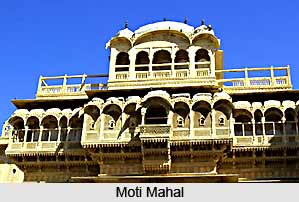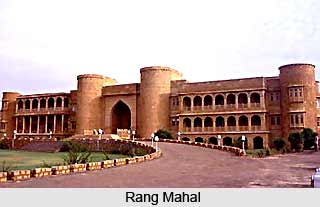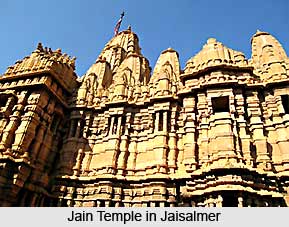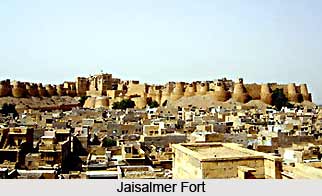 Monuments of Jaisalmer are well known for their architectural splendour. Located far out in the Thar Desert, Jaisalmer rises like a mirage from the sands, a huge fortified city in the middle of nowhere. Apart from the fort, there are a number of other monuments at Jaisalmer which evidence the might and grandeur of the Rajput warriors. The town was founded by Prince Jaisal in 1156, and functioned as the capital of the Bhatti Rajputs. It grew to be a major trade centre for camel trains, linking the routes from India to Egypt, Arabia, Persia, Africa and Europe and controlling the way into northern India across the desert.
Monuments of Jaisalmer are well known for their architectural splendour. Located far out in the Thar Desert, Jaisalmer rises like a mirage from the sands, a huge fortified city in the middle of nowhere. Apart from the fort, there are a number of other monuments at Jaisalmer which evidence the might and grandeur of the Rajput warriors. The town was founded by Prince Jaisal in 1156, and functioned as the capital of the Bhatti Rajputs. It grew to be a major trade centre for camel trains, linking the routes from India to Egypt, Arabia, Persia, Africa and Europe and controlling the way into northern India across the desert.
Architecturally, the city has a wonderful legacy of old buildings, united by the common use of local yellow-brown stone and beautifully preserved because of the isolated location. Stylistically, they are a blend of Rajput and Islamic influences, untouched by any European nuances. The monuments at Jaisalmer represent the rich artistic skill and creative imagination of the local craftsmen of the region. The various palaces, forts and religious monuments of Jaisalmer are beautifully ornamented with intricately carved works. Exquisite lattice work can be seen on the pillars, walls and ceilings of the various monuments. The traditional forts here display brilliant wood work carvings made by the indigenous craftsmen. The grandeur and artwork of the ancient artisans are a remarkable sight to behold, and make the monuments of Rajasthan a major tourist attraction.
 Chief among the various monuments of Jaisalmer is the fort found here. The Jaisalmer fort stands on Tricuta hill a height of 250 feet. It is enclosed by an imposing crenellated sandstone wall about 30 feet high, reinforced with ninety nine bastions. Of these ninety two were built between 1633 and 1647 for use as gun platforms. Water was provided for within the fort by means of wells found herein. There are four huge gateways leading up to the fort- Suraj Pol, Ganesh Pol, Hawa Pol and Bhoot Pol. A number of constructions are found within the fort, mainly temples and palaces. The royal apartments here include the Juna Mahal, the Rang Mahal, the Badal Mahal, the Sarvotam Vilas, Gaj Vilas, Moti Mahal and Zenana Mahal. To the north at Bada Bagh is the old royal cremation ground. The Royal Chatris, set in gardens, have fine carved ceilings.
Chief among the various monuments of Jaisalmer is the fort found here. The Jaisalmer fort stands on Tricuta hill a height of 250 feet. It is enclosed by an imposing crenellated sandstone wall about 30 feet high, reinforced with ninety nine bastions. Of these ninety two were built between 1633 and 1647 for use as gun platforms. Water was provided for within the fort by means of wells found herein. There are four huge gateways leading up to the fort- Suraj Pol, Ganesh Pol, Hawa Pol and Bhoot Pol. A number of constructions are found within the fort, mainly temples and palaces. The royal apartments here include the Juna Mahal, the Rang Mahal, the Badal Mahal, the Sarvotam Vilas, Gaj Vilas, Moti Mahal and Zenana Mahal. To the north at Bada Bagh is the old royal cremation ground. The Royal Chatris, set in gardens, have fine carved ceilings.
The group of Jain temples found within the fort date back to the twelfth and fifteenth centuries. The oldest is dedicated to Lord Parshvanatha.
 The town at the base of the citadel was enclosed by a fortified wall in 1750 by Maharawal Mulraj. There arc four important gateways to the city wall: Gadhisar Pol, leading to the Gadhisar Tank, which has a fine gateway adjacent to it; Amarsagar Pol; Baron-Ki-Pol; and Malka Pol. There are also two gateways to the south, which were later sealed.
The town at the base of the citadel was enclosed by a fortified wall in 1750 by Maharawal Mulraj. There arc four important gateways to the city wall: Gadhisar Pol, leading to the Gadhisar Tank, which has a fine gateway adjacent to it; Amarsagar Pol; Baron-Ki-Pol; and Malka Pol. There are also two gateways to the south, which were later sealed.
The Havelis of Jaisalmer, or mansions of the Rajput nobles are some extremely fine monumental constructions. They are beautiful town houses built of honey-coloured sandstone and enriched with delicately carved facades. They have balconies of the finest jail work overlooking the narrow streets. Behind these intricate stone screens the women withdrew in Purdah.
Salim Singh ki Haveli was built in 1815, possibly on the core of an earlier building of the late seventeenth century. It was the residence of the influential Mohta family. It has a beautifully carved roof and exquisite details in the carvings with brackets in the form of peacocks. The entrance is guarded by a large stone elephant. The Haveli is often called the Jahazmahal because the upper portion of the house oversails boldly like a ship`s prow. The top two stories -the Kanchanmahal and Rangamahal- were once adorned with glass mosaics and bright colours. The Haveli is currently still occupied.
 Nathmalji-ki-Haveli was built for the prime minister of the priestly state of Jaisalmer in 1885. The entrance is flanked by stone elephants and the entire facade is carved with a riot of ornamental detail - soldiers, horses, elephants, flowers and birds. The building was designed and built by two craftsmen-architects Hathi and Lulu. One architect carved on the left side and the other on the right, but the overall impact is of complete harmony. Unlike the usual style, the house is built of rock and not dressed stone. In the main room at first-floor level the entire front wall is a huge, single rock carved into a bay. The inner walls are counter pointed with beautiful miniatures.
Nathmalji-ki-Haveli was built for the prime minister of the priestly state of Jaisalmer in 1885. The entrance is flanked by stone elephants and the entire facade is carved with a riot of ornamental detail - soldiers, horses, elephants, flowers and birds. The building was designed and built by two craftsmen-architects Hathi and Lulu. One architect carved on the left side and the other on the right, but the overall impact is of complete harmony. Unlike the usual style, the house is built of rock and not dressed stone. In the main room at first-floor level the entire front wall is a huge, single rock carved into a bay. The inner walls are counter pointed with beautiful miniatures.
The largest and most elaborate of all the Havelis is the Patwon ki Haveli. It was built in 1805 as one of a group of five built for the Patua brothers. The entire front is carved with elaborate detail. It stands in a narrow alley and has beautiful murals.
Yet another haveli, the Simla Haveli is a 500 year old building in the Jaisalmer fort. The Haveli of the Prime minister of Jaisalmer is the Haveli Shreenath. It is a beautiful 450 year old Haveli which was once occupied by the Prime Minister under the Maharajah. The haveli has gorgeous archways, alcoves and spacious rooms.
The Mehra Haveli was built by the Mayor of Jaisalmer city, Gopikishen Mehra. It was named after his grandmother Parwati Devi as Parwati Sadan. On the other hand, the Jawahar Niwas lies outside the town. It is an opulent palace built as a guest-house for private visitors. On the banks of the Amar Sagar, a few miles west of Jaisalmer, is the pleasure palace of Amar Singh, built around a courtyard with an extensive formal garden.
There has been increasingly seen a resurgence of the town due to the military presence here. Jaisalmer is a popular site for tourists as it still tells the tale of the glorious Rajputs through its various monuments.



















